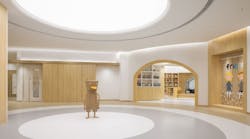The typical kindergarten classroom in North America is characterized by bright paint colors, whimsical signage and displays, and multicolored furniture and flooring intended (presumably) to stimulate children’s imaginations. The end result, however, is a space that feels cluttered if not overwhelming.
Crown Dream International Kindergarten is a recently renovated elementary school located in the Xiangmihu area of Futian District in Shenzhen, China, that takes a decidedly different approach to the kindergarten classroom model. VMDPE Design (VMDPE) was brought on as architect to build a high-end educational institution with Early Years Foundation Stage (EYFS) as its teaching philosophy, using a more understated design methodology. (EYFS is the statutory framework for Early Years education in England.)
The client’s goal for this project was to provide a high-quality education space for the locals of the area while maintaining a reasonable budget, said Vinci Chan, chief designer for VMDPE. “Therefore, we did not use too many decorative elements for the design. Instead, we enhanced the functionality of the campus and at the same time enriched the diversity of teaching spaces, so that there are more possibilities for creating different teaching scenes.”
Eastern Inspiration
The design team was inspired by Eastern culture, which emphasizes the harmonious coexistence of people and the environment. “Our purpose is not to give the space a strong, fixed personality but to allow people to change the space for their needs while using it,” Chan noted.
This minimalist approach is evident in the use of natural wood and ample white space throughout, which also serves the dual function of providing plenty of room to pin up children’s artwork and projects.
[Related: Berkner STEM Exploration Center Uses Strategic Interior Design to Engage Students]
VMDPE Design located reception, administrative offices, security, meeting rooms, logistics and medical services on the first floor of the 16,000-square-foot project. A central storage area for changing shoes isolates outdoor dust and dirt, and prevents their spreading to the rest of the building. Additionally, a spacious hall in the lobby provides sufficient room to facilitate a morning health check-in to the kindergarten, as well as large-scale events and gatherings.
The primary classroom spaces are on the second and third floors.Upon entry, students, teachers and visitors are greeted by a large circular, open reading area with an abundance of natural light. The ceiling has a dimmable light source to meet the soft ambience required for children's indoor reading. In addition, there are classrooms for exploration courses arranged around the reading area.
VMDPE Design has been exploring various methods to eliminate corridors in their projects. This design decision is driven by the belief that corridors serve simply as secondary space linking other programmed spaces, with their main function being to manage traffic rather than to allow people to freely explore a space. Therefore, the design team organized and distributed the lines of circulation linking all the classrooms at Crown Dream Kindergarten through the integration of all the corridor areas into a large activity space.
Flexibility & Sustainability
The children’s activity space is designed to be adaptable, depending on evolving teaching content, which also allows students to explore their environment and learn. For the teachers, it was important to have a space which is flexible enough to accommodate a variety of learning activities in the future, Chan explained.
“Our design is [intended] to support the functions needed in the learning process and make the teaching process easier and more convenient,” he said. “That is why we emphasize valuable aspects such as safety, easy-to-clean-, easy-to-store- and easy-to-perform-activities in different kinds of weather.”
Sustainability and health were also important drivers of the project. Designers ensured access to plenty of natural light and good air circulation in each space in accordance with the varying orientations of the different classrooms.
“Because we are a team that specializes in designing children’s educational spaces, the use of environmentally friendly and renewable materials is one of our main goals, helping children to grow up with an environmental, sustainable idea from an early age,” Chan said. “For example, the outdoor floor rubber we use is made of waste tires after a secondary recycling process. At the same time, we don’t use paint-coated materials in our designs, and for some locations that need to be soft-treated, we use artificial leather instead of real leather.”
The school also features a 7,500-square-foot outdoor area which occupies the third-floor roof of the building. It includes a generous outdoor activity space complete with supporting facilities such as a STEAM (Science, Technology, Engineering, the Arts and Mathematics) learning zone, small farm, sand pit and water play area. There are multiple gathering areas and stages, as well as a multifunctional hall for performances, dance rehearsals and other functions.
In many ways, the Crown Dream project is a return to original design principles for VMDPE Design. “We hoped to think about the design of the kindergarten space from a more essential point of view—putting aside adult aesthetic concepts in favor of a perspective which emphasizes warmth, sunshine and exploration, and above all, tolerance,” Chan said. “By also bearing in mind the teaching activities that will occur in the space in the future, we strove to create a project that was simple and coherent, but full of possibilities for children's space design.”
Read next: Formica Announces Winners of 2021 FORM Student Innovation Competition

